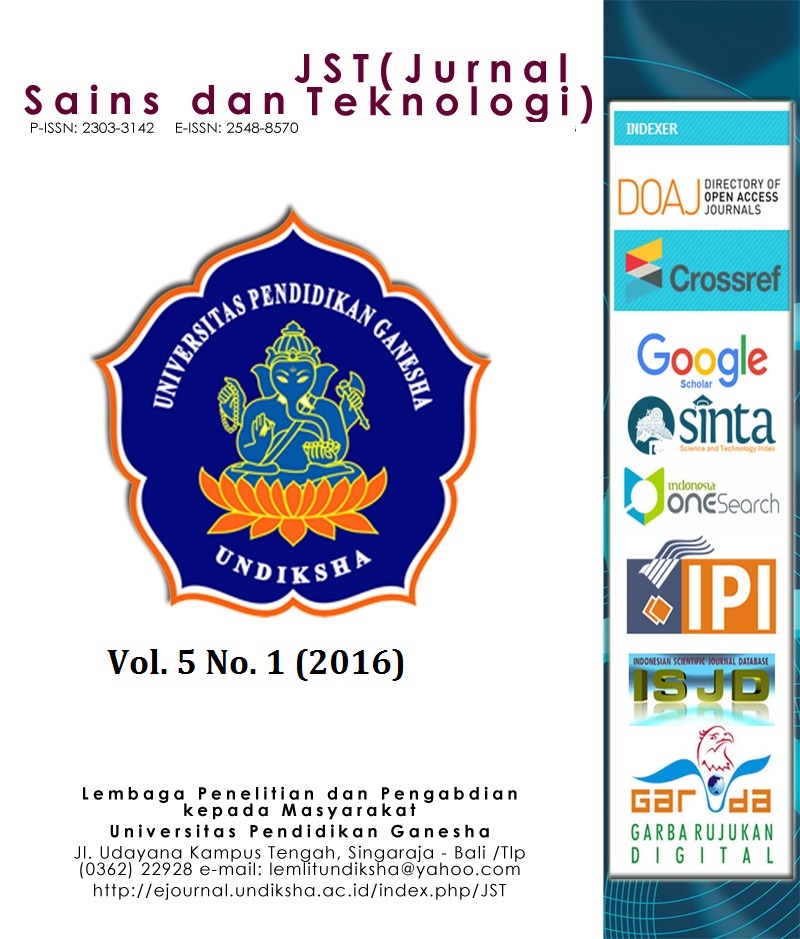FOTODEGRADASI METHYL ORANGE DALAM REAKTOR FIXED BED BATU APUNG-SEMEN
DOI:
https://doi.org/10.23887/jstundiksha.v5i1.8275Abstrak
Abstrak Tujuan penelitian ini adalah untuk mengetahui karakteristik batu apung dan semen yang digunakan sebagai bed dalam reaktor fixed bed dan efektivitasnya dalam mendegradasi methyl orange akibat pengaruh pH larutan dan sinar dalam sistem reaksi. Bed yang digunakan adalah batu apung berukuran kecil dengan perekatan semen dalam cetakan stainless steel berukuran 5x16x16 cm. Fotodegradasi methyl orange dijalankan pada pH larutan 7 dan diberikan sinar 2 buah lampu UV Sankyo Denky FT10T8BLB FL10BLB 10 W 325 nm selama 1, 2, 3, 4, 5, 6 dan 7 jam. Methyl orange disirkulasi pada temperatur kamar dari tangki penampungan menuju reaktor fixed bed menggunakan pompa dengan debit sebesar 6,89 mL/detik. Batu apung dan semen yang digunakan sebagai bed dianalisis bentuk dan unsur yang dikandungnya dengan menggunakan SEM EDX. Konsentrasi methyl orange sebelum dan setelah proses fotodegradasi diukur dengan menggunakan spektrofotometer UV Visibel Shimadzu 1240. Hasil penelitian menunjukkan bahwa batu apung memiliki bentuk yang tidak beraturan dengan kandungan unsur tertinggi berupa Si sedangkan semen yang digunakan sebagai perekat memiliki bentuk seperti butiran yang homogen dengan kandungan unsur tertinggi Ca. Fotodegradasi methyl orange berjalan optimum pada pH 3 untuk waktu penyinaran 7 jam sebesar 40,37%. Degradasi methyl orange berlangsung efektif dengan adanya sinar dibandingkan tanpa penyinaran. Reaksi fotodegradasi methyl orange mengikuti kinetika reaksi orde satu semu dengan nilai k sebesar 0,0378 jam-1. Kata kunci : batu apung-semen, fotodegradasi, methyl orange, reaktor fixed bed Abstract The objectives of this research were to know the characterization of pumice stone and cement used in fixed bed reactor. The fixed bed used was made from pumice stone with a gluing cement in 5x16x16 cm stainless steel mold. Methyl orange photodegradation were carried out with pH 1, 2, 3, 4, 5, 6, 7, 8, 9, 10, 11, 12, 13,and 14 and irradiated by 2 lamps of UV Sankyo Denky FT10T8BLB FL10BLB 10 W 325 nm for 1, 2, 3, 4, 5, 6 and 7 hours. Methyl orange was circulated at room temperature from its reservoir to fixed bed reactor by a pump with 6.89 mL/s. Pumice stone and cement were analyzed by SEM EDX to know its characterization. Methyl orange concentration before and after photodegradation were measured by UV Visible Spectrophotometer Shimadzu 1240. The result showed that pumice stone has irreguler shape with the highest material is Si and cement has homogeneous granule with the highest material is Ca. The best fotodegradation of methyl orange with UV irradiation at pH 3. Methyl orange photodegradation follows pseudo first order kinetics with reaction constant 0,0378 hour-1. Keywords : fixed bed reactor, methyl orange, pumice stone-cement, photodegradationUnduhan
Cara Mengutip
Yuningrat, N., Retug, N., & Gunamantha, I. (2016). FOTODEGRADASI METHYL ORANGE DALAM REAKTOR FIXED BED BATU APUNG-SEMEN. JST (Jurnal Sains Dan Teknologi), 5(1). https://doi.org/10.23887/jstundiksha.v5i1.8275
Terbitan
Bagian
Articles
Lisensi
Authors who publish with the Jurnal Sains dan Teknologi (JST) agree to the following terms:
- Authors retain copyright and grant the journal the right of first publication with the work simultaneously licensed under a Creative Commons Attribution License (CC BY-SA 4.0) that allows others to share the work with an acknowledgment of the work's authorship and initial publication in this journal.
- Authors are able to enter into separate, additional contractual arrangements for the non-exclusive distribution of the journal's published version of the work (e.g., post it to an institutional repository or publish it in a book), with an acknowledgment of its initial publication in this journal.
- Authors are permitted and encouraged to post their work online (e.g., in institutional repositories or on their website) prior to and during the submission process, as it can lead to productive exchanges, as well as earlier and greater citation of published work. (See The Effect of Open Access)
















